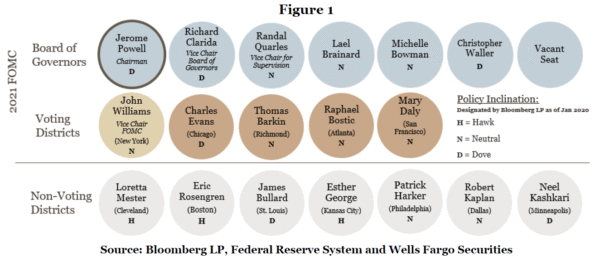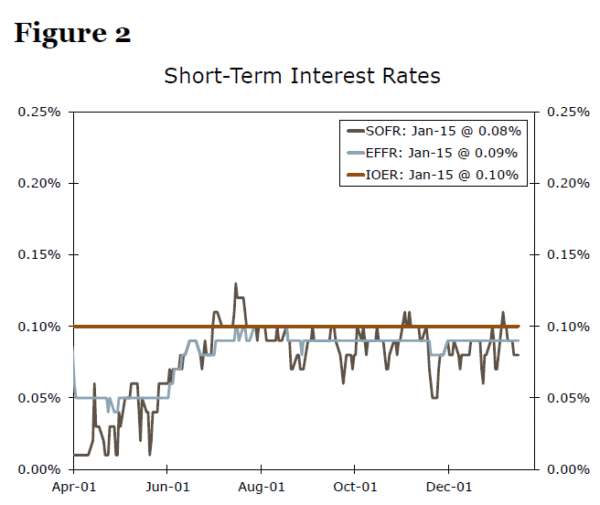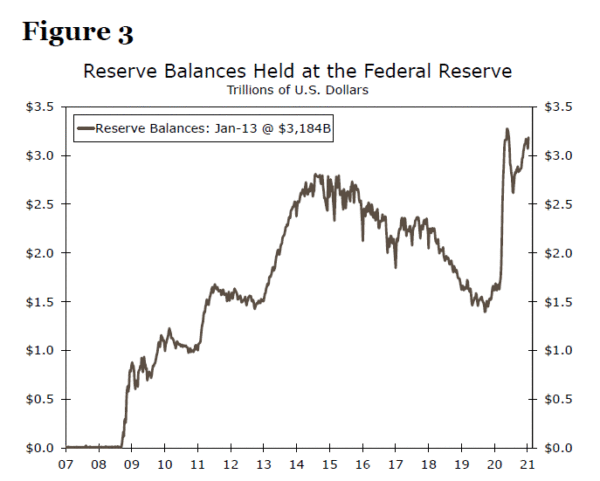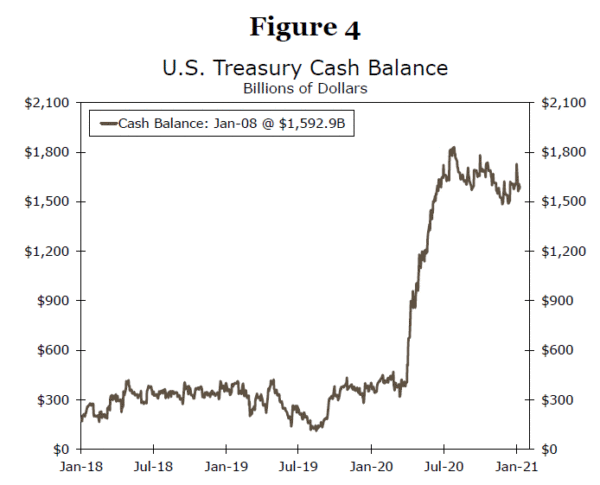Executive Summary
The January 26-27 meeting of the Federal Open Market Committee (FOMC) is now eleven days away, and we have entered the blackout period when committee members refrain from public comments. Notably, this will be first meeting to occur during the Biden administration, and in keeping with schedule, the first meeting of the year also means a rotation of regional board governors as well as the addition of new Board Governor Christopher Waller. In this edition of the Flashlight for the Blackout Period, we breakdown the new seating assignments and what it means for policy.
In the lead-up to the blackout period, a number of Fed officials have been addressing the timing of the eventual dialing back of the asset purchase programs that helped the financial system function smoothly throughout the pandemic. Although we do not expect the FOMC will increase the size or the composition of its asset purchase programs at this meeting, the committee could potentially provide some guidance on the conditions that will be needed before it starts to wind down those programs. While 10-year benchmark Treasury yields rose considerably at the start of this year, short-term yields like the effective fed funds rate remain quite low. This has some market participants wondering if the Fed may eventually raise the rate of interest it pays on excess reserves (IOER). In the pages ahead, we describe how the recent stimulus bill factors into the Fed’s calculus for that decision.
New Voters, Same Policy Outlook
The first FOMC meeting of the year will usher in a new crop of voters (Figure 1). On net, the rotation of regional Fed presidents means one less hawk and one more centrist voter. The slight shift to the middle of the policy spectrum is likely to be reinforced by the confirmation of Christopher Waller, previously research director at the St. Louis Fed, to the Board of Governors since the FOMC’s last meeting in December.
Overall, we view the 2021 voting group as only marginally more dovish and the compositional shift as insignificant this year. Not only are there likely to be more centrists voting, but policy is not currently at a major inflection point. Based on recent statements and the December meeting minutes, FOMC members appear in widespread agreement that the current degree of accommodation will remain in place for some time. Furthermore, voting or not, all committee members have a voice at the table and are able to influence the policy debate.
With a new administration entering the White House and the Democrats controlling the Senate, it is worth discussing how the composition of the Board of Governors may evolve this year. Governors to the Federal Reserve Board are appointed by the president and confirmed by the Senate. Therefore the Biden administration should not have too much trouble filling the one remaining vacancy on the Board of Governors. A more substantial reshaping of the Board and consequently the FOMC, however, could begin late this year. Randall Quarles’ term as Vice Chair of Supervision ends in October. We suspect he will not be reappointed to that role as the Biden administration tries to put its own stamp on financial system regulation, and Quarles may well resign from his Board seat.1 More importantly for the path of monetary policy, Jerome Powell’s term as FOMC Chair expires in February 2022. If not reappointed, he could choose to leave the Fed before his Board term expires in 2028. The Board could lose another key driver of policy around the same time with the expiration of Board of Governors Vice Chair Richard Clarida’s term in January 2022.
That said, we do not think the Biden administration will be eager to steer the Fed in a significantly different direction. After all, under the Fed’s updated Longer-Run Goals and Monetary Policy Strategy, which was unanimously supported in August, the FOMC looks set to be more tolerant of inflation following a decade of undershooting its 2% goal. At the same time, the FOMC seems less concerned about the labor market overheating as it formulates policy, focusing on shortfalls from “maximum” employment and the inclusive nature of its labor market mandate.
IOER Tweak Not Imminent, but Might Be Inevitable
Towards the end of 2020, some analysts, including us, began to discuss the possibility that the Fed may need to increase the interest rate paid on excess reserves (IOER). Lorie Logan of the Federal Reserve Bank of New York brought the issue into focus in a December 1 speech when she highlighted some of the reasons an IOER tweak could become necessary.2 The effective fed funds rate was floating around 8-9 bps at the time, towards the lower end of the Federal Reserve’s target range of 0.00%-0.25% (Figure 2). While this is not necessarily a problem, two factors could drive steady growth in banks’ reserve balances, exerting additional downward pressure on short-term interest rates.
First, the Federal Reserve continues to buy $80 billion of Treasury securities and $40 billion of mortgage-backed securities (MBS) per month. To finance these purchases, the Federal Reserve creates reserves and credits them to the accounts of the financial institutions from which the Fed is purchasing the securities. Thus, the Fed’s asset purchases continue to expand the supply of bank reserves. As can be seen in Figure 3, bank reserves have been growing for the past several months and are nearing the high reached during the initial wave of the pandemic. Our expectation is that the Fed will continue buying Treasury securities and MBS at the current pace through at least the end of 2021. If realized, this could add another $1.4 trillion to total bank reserves, all else equal.
Second, the Treasury’s General Account (TGA) held at the Federal Reserve remains elevated by historical standards (Figure 4). Since August, the U.S. Treasury had been assuming in its borrowing projections that a $1 trillion deficit-financed fiscal relief package would be enacted. To ensure that there was plenty of money on hand in the event this assumption became reality, the Treasury has maintained a much higher cash balance than it otherwise would have. In late December, a $900 billion package became law, and money started to flow out the door right around the turn of the year. Subsequently, we anticipate that the TGA will start to decline to more “normal” levels in the months ahead, and probably reach an “equilibrium” level of about $800-$900 billion by midyear.
But what does a decline in the TGA have to do with IOER and money market rates? The TGA is a liability of the Federal Reserve, just like a checking account balance held by an individual is a liability of a commercial bank. When the TGA declines, a liability on the Fed’s balance sheet is shrinking. Thus, to keep the balance sheet balanced, either assets must decline or another liability must increase. Since the Fed is extremely unlikely to start selling assets, this must mean another liability somewhere else on the balance sheet is growing. For the most part, this other liability is bank reserves.3 A decline in the TGA should see a roughly proportional increase in bank reserves, all else equal.
Pulling all this together, the combination of a lower TGA balance and continued Fed purchases means that bank reserves could rise by $1.5-$2.0 trillion by year-end, if policy evolves as expected. With so many more reserves sloshing around the system, and with banks fighting downward pressure on their net interest margins, financial institutions will have a strong incentive to hunt down yield in money markets. This in turn could put further downward pressure on short-term money markets rates like Treasury repo and fed funds. And if the downward pressure is strong enough, the fed funds rate could drift even lower, precipitating an upward tweak in IOER as a countermeasure.
For now, the effective fed funds rate remains well-anchored around nine bps, and the TGA has not moved much relative to the last FOMC meeting on December 16. Given this, we do not anticipate any changes to IOER at the January 27 FOMC meeting. But, we see the potential for one or more IOER tweaks at some point in the next six months or so.
In Case of Emergency, Ask Congress for Permission?
In our previous FOMC Flashlight piece, we explained how recent actions taken by Treasury Secretary Mnuchin would end several Federal Reserve (13)3 emergency lending programs, most notably the Main Street Lending Program (MSLP), the Municipal Liquidity Facility (MLF) and the Corporate Credit Facilities (CCF). However, we argued at the time that the Fed could restart these programs in 2021 using funds from the Exchange Stabilization Fund (ESF) if the central bank felt it was necessary and the incoming Treasury Secretary signed off.
Based off our understanding, the budget/COVID relief bill passed by Congress at the end of 2020 nixes this possibility. The legislation contained language stating that the ESF cannot be used to fund any program that is the “same” as one that received funds in the CARES Act, except for the Term Asset-Backed Securities Loan Facility. The legislation was careful not to tie the Federal Reserve’s hands too tightly; it also contained language stating that “nothing in this Act shall be construed to modify or limit the authority of the Board of Governors of the Federal Reserve System under section 13(3) of the Federal Reserve Act as of the day before the date of enactment of the CARES Act.”
Thus, if our reading of this section of the bill is correct, it would be exceptionally difficult for the Federal Reserve to unilaterally restart the aforementioned facilities in 2021, but it can continue to operate the numerous other programs it runs without CARES Act funding, including asset purchases of Treasury securities and MBS, central bank FX swaps, the Primary Dealer Credit Facility, the Commercial Paper Funding Facility and the Money Market Mutual Fund Liquidity Facility. At a high level, this should not have a major impact on our forecasts for real GDP growth, nonfarm payrolls, etc. Take up of the CARES Act supported facilities such as the MSLP and MLF has been low, so the near-term impact of their termination should be relatively muted. But, should the economy take a major turn for the worse, these facilities would no longer serve as a credit backstop for businesses and state & local governments.
Of course, should financial markets and the economy deteriorate markedly, the Federal Reserve could always go to Congress and request the authority to restart these programs. In such a scenario, fiscal policymakers would likely be weighing yet another emergency package to keep the economy afloat, so the legislative vehicle for such a move would probably exist. But, time can be critical in a crisis, and Congress does not always act with a swift decisiveness. So while the elimination of these 13(3) programs does not have a major impact on our baseline forecast, it does create some small but clear tail risks to the downside.
















